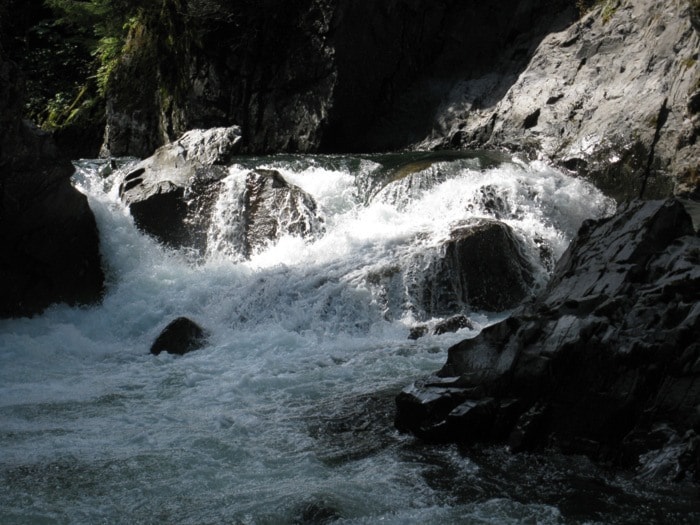LARGE CEMENT blocks have been airlifted by helicopter and placed in a northwestern river to help returning salmon reach their spawning beds. The blocks are meant to raise a pool just below a waterfall created by a rock slide in the Kwinageese River, a tributary of the Nass River.
Salmon haven’t been able to jump the falls, approximately three metres high, nor have they been able to get close enough so that when they do leap, their tails can churn the water for added momentum.
Raising the pool means a shorter jump for the fish and a better chance of clearing the waterfall, says Nisga’a Lisims Government fish and wildlife director Harry Nyce.
“It was a combination of putting our heads together – our people, federal fisheries and our biologists,” said Nyce.
The need to act as quickly as possible was driven by the presence of fish in the pond below who need to continue upriver to spawn. “There’s been a lot of cooperation on this,” added Nyce of meetings between provincial, federal and Nisga’a officials.
A plan was formulated in late July and into early August with final permits being issued late last week.
A long-term approach will be to blast the slide but that cannot happen until the winter season when water levels are low, said Nyce said. “We'll all be needing to sit down and work on that one,” he said, adding that crafting a blasting program would be a complex operation.
Officials first, however, will be watching closely and waiting to determine the effectiveness of last week's block placement.
Nearly 40 blocks were assembled and the whole project is expected to cost $50,000 shared by a number of agencies.
Biologists and others with the Nisga’a Fisheries and Wildlife Department first began to notice a large drop in spawning Kwinageese salmon two years ago.
While Kwinageese numbers were healthy at test fishery locations, very few were making it upriver to spawn, says biologist Richard Alexander.
This year, the federal Department of Fisheries and Oceans closed a portion of the Nass commercial sockeye run and the Nisga’a also restricted fisheries to allow as many Kwinageese salmon as possible to get upriver. But suspicions grew that there might be a physical obstruction of some sort blocking the Kwinageese return.
Several locations were examined but one fit the bill – a spot where large chunks of rock sheared off a canyon wall and into the river, creating a waterfall of approximately three meters in height. “What we say is that anything above two metres is impassable. That’s six and a half feet,” said Alexander. “At three metres, you're getting on to 10 feet.”
Fisheries officials estimate the blockage is at least several years old, explaining the low spawning numbers of 2009 and last year, and may even be older.
Alexander said satellite imagery dating back several years is being examined to see if a definite date can be determined.
That’s important because fisheries officials will then have a better idea of the kinds of closures and restrictions that will be needed in the next years to ensure as many Kwinageese salmon as possible make it up the Nass to their spawning beds.
As it is, Alexander said everyone is aware that returns for 2014 and 2015 (fish hatched from 2009 and 2010 spawners) will be very, very low because of the blockage.
